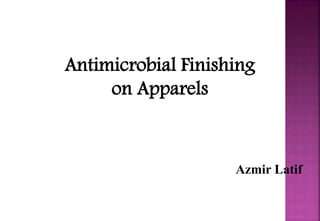This document discusses antimicrobial finishing on apparels. It defines antimicrobial and antimicrobial agents as chemicals that prevent or inhibit microbial growth. The objectives of antimicrobial finishing on apparels are to prevent cross-infection, reduce odor formation, safeguard fabrics from staining and deterioration, and protect performance. It also discusses types of microbes, evaluation methods, where antimicrobial finishing can be applied, and types of finishes including biostats and biocides.




























